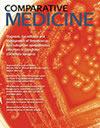COVID-19 and Animal-Based Research.
IF 1.1
4区 农林科学
Q2 VETERINARY SCIENCES
引用次数: 0
Abstract
In June 2017, AALAS published a special topic issue of Comparative Medicine on infectious disease research.14 The issue included articles on risk management, including occupational health and safety oversight5 and use of personal protective equipment,13 and finally, articles on 2 emerging diseases (Ebola9 and Zika1 virus infections) that were specifically chosen because, they were the most recent community outbreaks the world had seen. Fastforward to 2020, this special topic issue focuses on COVID-19, the new epitome of the modern-day pandemic. The pandemic started in late 2019 when cases of pneumonia of unknown etiology occurred in Wuhan, China. The novel virus was soon identified as severe acute respiratory syndromecoronavirus-2 (SARS-CoV-2), which caused a disease that has been termed as COVID-19, spreading throughout the world and officially being declared by the World Health Organization as a pandemic on March 11, 2020.12 As of end of September 2021, more than 230 million cases and 4.7 million deaths have occurred globally, with over 43 million cases and nearly 700,000 deaths in the United States.7 While we continue to navigate through this pandemic as it sickens people and claims lives, wreaking havoc to families, communities, and nations, we find science and technology center to global, national, and local response efforts to derail its destructive path.

COVID-19和动物研究。
本文章由计算机程序翻译,如有差异,请以英文原文为准。
求助全文
约1分钟内获得全文
求助全文
来源期刊

Comparative medicine
医学-动物学
CiteScore
1.90
自引率
0.00%
发文量
71
审稿时长
6-12 weeks
期刊介绍:
Comparative Medicine (CM), an international journal of comparative and experimental medicine, is the leading English-language publication in the field and is ranked by the Science Citation Index in the upper third of all scientific journals. The mission of CM is to disseminate high-quality, peer-reviewed information that expands biomedical knowledge and promotes human and animal health through the study of laboratory animal disease, animal models of disease, and basic biologic mechanisms related to disease in people and animals.
 求助内容:
求助内容: 应助结果提醒方式:
应助结果提醒方式:


